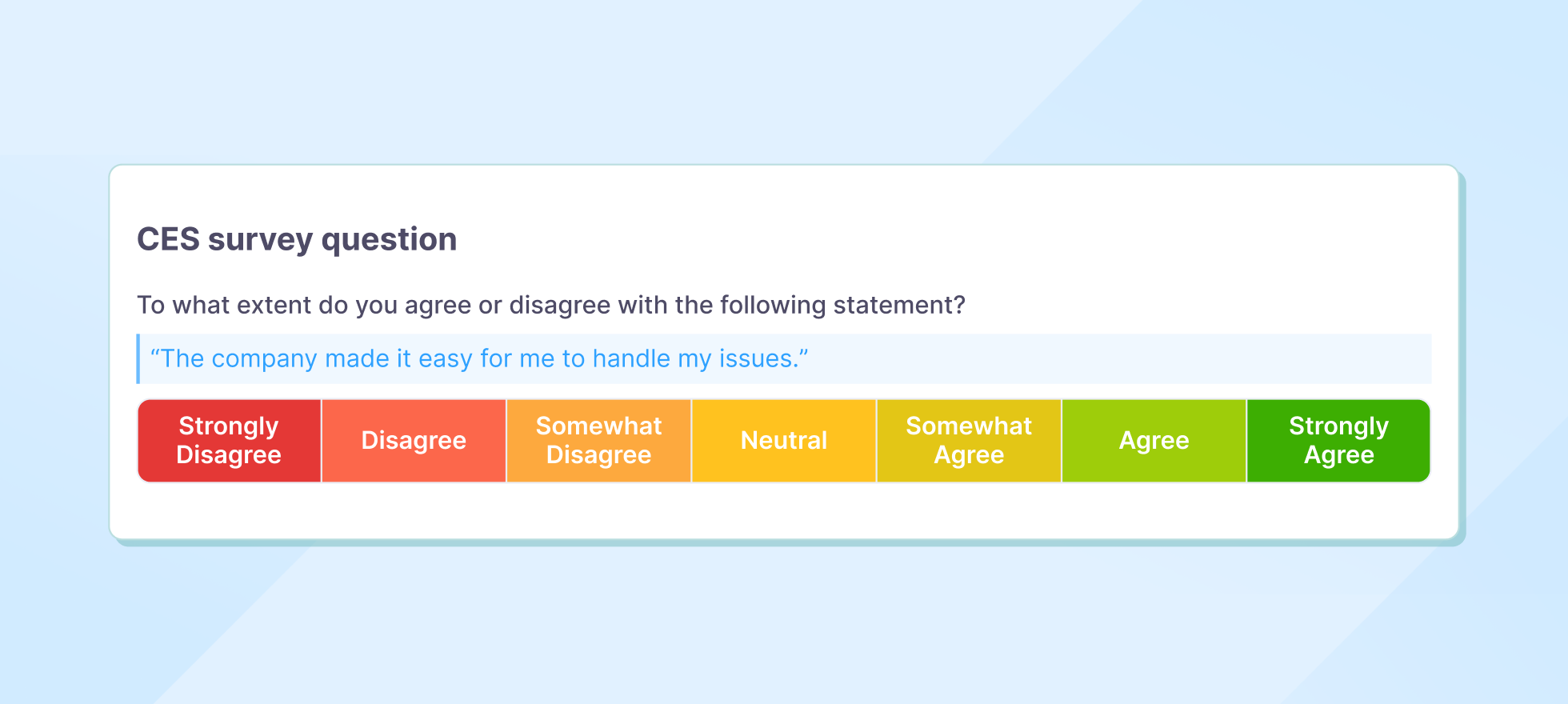
As a business owner or marketer, you want to ensure that your products or services meet your customers’ needs. One of the best ways to make sure of this is by collecting customer feedback through voice of the customer (VoC) survey questions. However, creating this kind of questions can be a challenging task.
In this blog post, we’ll discuss the benefits of VoC surveys and provide some examples and templates to help you get started.
What is a voice of the customer survey?
A VOC survey is a research method that collects customer feedback about their experiences with your business. It typically includes questions about satisfaction levels, areas for improvement, and overall perceptions of your brand.
According to Zendesk, repeated bad customer experiences will drive 73% of customers to switch to a competitor. A VOC survey can help you pinpoint trends in customer feedback, enabling you to prioritize your efforts and make improvements that significantly impact user satisfaction.
Additionally, it allows you to collect and analyze interactions from touchpoints in the customer journey. VoC and sentiment analysis tools can collect and analyze these interactions to uncover pain points across the entire journey. The inclusion of an additional sentiment element allows you to gain a deeper understanding of your customers’ emotions.
VoC surveys offer a distinct advantage over conventional customer feedback or satisfaction surveys by providing both quantitative and qualitative perspectives on customer interactions.

Best practices for creating VOC surveys
Best practices for creating a VOC survey include:
- Defining the objectives
- Identifying the target audience
- Choosing the suitable survey method and carefully developing survey questions
- Analyzing the results.
Before creating a VOC survey, ask yourself a series of questions to ensure that you are developing the right kind of voice of customer questions based on your business needs:
- What are the specific goals of the survey?
- Who is the target audience for the survey?
- What are the best channels to reach this audience?
Also, consider the length and format of the survey and the types of questions that will likely get the most helpful feedback.
Once you have defined your objectives and audience, you can develop the appropriate survey questions. These may be open-ended or closed-ended questions.
Open-ended questions can provide valuable insights into your customers’ opinions and experiences.
However, closed-ended questions can be easier to analyze, and you can use them to gather quantitative data that’s more straightforward to measure.
| Open-ended questions | Closed-ended questions |
| Can you tell us about your experience with our customer service? | On a scale of 1 to 10, how satisfied were you with our customer service? |
| Were there any challenges you faced when using our product/service? | Did you find our product easy to use? |
| What features would you like to see in future versions of our product/service? | Would you recommend our services to others? |
| How did our product/service contribute to your company’s overall success? | Did our website meet your expectations? |
Analyzing the survey results and using the insights gained to improve your products, services, and customer experience is crucial. By following these best practices, you will be able to create effective VOC surveys that will provide you with valuable insights into your customer’s needs and preferences.
Voice of the customer survey questions
To design an effective VOC survey, it is essential to include the right questions to elicit insightful and actionable responses. Below we share some examples of effective voice of the customer survey questions. If you’re looking for more feedback or satisfaction survey examples, check out our article with survey questions organized by user journey.
1. Value or results-based VOC survey questions

Value-based questions are used to check how the customer sees the product/service based on its usefulness, quality, and overall value. They can be open-ended or close-ended questions and can be asked in various ways, such as asking the respondent to give something a rating of 1— 10 or to describe their experience.
Results-based questions, on the other hand, focus on what happens after a customer has used the product or service. The responses to these questions can help you understand if your product/service has met the desired outcomes of the customers and helped them- achieve their goals.
- On a scale of 1 to 10, how would you rate the value of your purchase?
- When selecting a product, what are the most critical features you consider? (You may choose from a range of multiple-choice answers or add your own if not listed.)
- How did you first hear about our company/product?
- How likely are you to recommend our product/service to a friend or colleague?
- How often do you use our product/service?
- How satisfied are you with the quality of our product/service?
- What improvements would you suggest we make to our product/service?
2. Brand loyalty or brand perception questions

Brand loyalty questions in VOC surveys are designed to measure the extent to which customers are committed to a particular brand. These questions can include asking customers to rate their level of satisfaction with your brand, their perception of your brand’s quality and value, and their overall impression of the brand.
By analyzing the responses, your business can determine where to enhance your branding, marketing, or customer service strategies to satisfy your customers’ expectations and requirements. Some typical questions include:
- How likely are you to continue using our product/service in the future?
- How likely are you to recommend our product/service to friends or family?
- How satisfied are you with our brand compared to our competitors?
- How does our brand make you feel?
- How important is our brand reputation when deciding to use our product/service?
- How do you perceive our brand in terms of quality and value?
3. Customer satisfaction questions

One key benefit of including customer satisfaction questions in VOC surveys is that they can allow your business to identify areas for improvement. If many of your customers report dissatisfaction with a specific product or service, such as customer support, you can focus on improving that aspect.
For example, you can improve your customer support service by investing in more training for support staff or streamlining the support process.
Here are some example customer satisfaction questions that you could ask in a voice of customer survey:
- How satisfied are you with our product/service in terms of meeting your business needs?
- How well does our product/service align with your business goals?
- How would you rate the quality of our product/service?
- From 1 to 10, how responsive and helpful is our customer support team?
- How likely are you to renew your subscription?
- How likely are you to recommend our product/service to others?
4. Follow-up or cascading VOC questions

Asking follow-up questions on quantitative questions can give you a more complete picture of a particular answer.
Using only a few questions in your voice of customer survey (we suggest a maximum of six), you can get insights into a few key issues, and that’s fine if you want to focus on a limited number of areas.
But to collect more information over time, we suggest using cascading questions. This will allow for a more personalized customer experience and can provide more information to help you analyze the root causes and drivers of issues more accurately. Some common questions include:
- Have you ever switched from our product to a competitor’s product? If so, why?
- What features or benefits do you think our competitors offer that we do not?
- How important is brand reputation when deciding which product to purchase?
- How does our pricing compare to other options you are considering?
- In your opinion, which competitor offers the best overall value for the price?
- What would be a deal breaker for you when deciding whether or not to purchase our product or service?
Different motives require different methodologies when it comes to VOC surveys. Here’s how you can include the questions above in different voice of the customer surveys:
Customer effort score (CES)
CES surveys evaluate how easy or difficult it was for customers to interact with you and how much effort they had to put in to resolve their issue. Typical questions include:
- How easy was it to find the information you were looking for on our website?
- Were there any obstacles that prevented you from completing a purchase?
- To what extent do you agree with the following sentence? – The company made it easy for me to handle my issue.

Customer satisfaction (CSAT)
CSAT surveys evaluate how satisfied customers are with your brand. They can focus on a specific transaction or on the overall customer-brand relationship to provide a comprehensive understanding of how customers perceive your business. Typical questions you might use on the voice of the customer survey include:
- How satisfied are you with the quality of our product/service?
- How likely are you to return to our website?
Net promoter score (NPS)
NPS surveys are among the most commonly used surveys for measuring brand loyalty. Common questions include:
- On a scale of 0-10, how likely are you to recommend our product/service to a friend or colleague?
- What is the primary reason for your score?
By understanding which type of survey best suits your needs, you can gather valuable customer information to make you make informed business decisions.
How to leverage voice of customer survey results
After conducting a VOC survey, you can use the gathered data to make informed decisions about enhancing your products or services.
Start by analyzing the survey responses to identify any areas where your business can improve in real time. Look for patterns or trends in the data, and create action plans that target the most critical areas for improvement.
Here’s a simple way to analyze VOC data to ensure you and take appropriate action:
| Customer complaints | Customer expectations | How you can solve your customer’s problems |
| Slow response times | Fast response to their questions or complaints | Implement a system to prioritize and quickly respond to customer inquiries and issues |
| Lack of personalization | Customized solutions for their specific needs | Conduct research to identify the target audience’s most common needs and pain points and then develop more personalized solutions to meet customer needs better. |
Track your action plan’s progress regularly to measure its effectiveness and identify any enhancements necessary to meet your customers’ needs and expectations.
By effectively using your voice of customer survey data, you can implement meaningful changes that will benefit your business.
Conclusion
By asking targeted questions and actively listening to customer responses, businesses can gain valuable insights into their needs and preferences, which can inform their decision-making and drive business success.
To create a compelling voice of the customer survey, it’s essential to follow best practices such as defining clear objectives, selecting the right questions, and ensuring the survey is easy and convenient to complete.
Frequently Asked Questions (FAQs)
The VoC framework is a systematic approach to listening and responding to customers through surveys and data analysis.
It involves capturing both emotional and practical feedback, which guides improvements in products and services.
The five key stages in a VoC study include defining objectives, selecting the right audience, developing targeted questions, gathering feedback, and reviewing results to guide improvements.
Textmagic can assist with the outreach and data collection steps.
It’s generally best to keep surveys brief, ideally between four and six questions, to gather meaningful feedback without overwhelming respondents.
The best timing for VoC surveys depends on your goals and customer interactions.
Some companies send surveys right after purchases or support calls to capture fresh opinions, while others conduct them every few months to monitor trends.
Questions that explore how customers would like a product to fit into their processes can help shape design choices.
This feedback ensures that development focuses on usability and value.
Related articles
How to promote your business with commercial text marketing
In a world where the average attention span is just ...
How to elevate customer service through automated email responses
Check out the best practices for automating support ...
5 Effective strategies to improve SLA response times
The SLA response time metric in service level agreem...
What is CPaaS (Communications Platform-as-a-Service)?
Communications Platform as a Service (CPaaS) is cruc...
16 Key metrics for measuring and improving customer engagement
Customer engagement metrics assess the emotional con...




